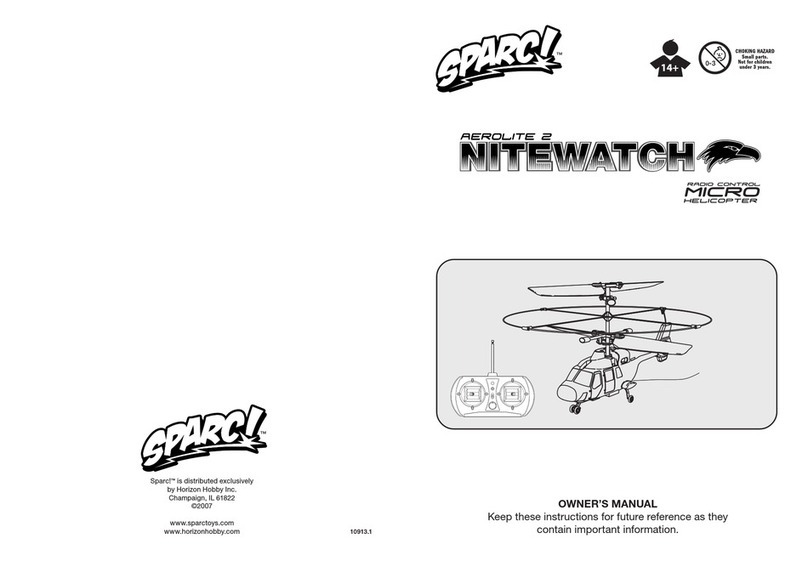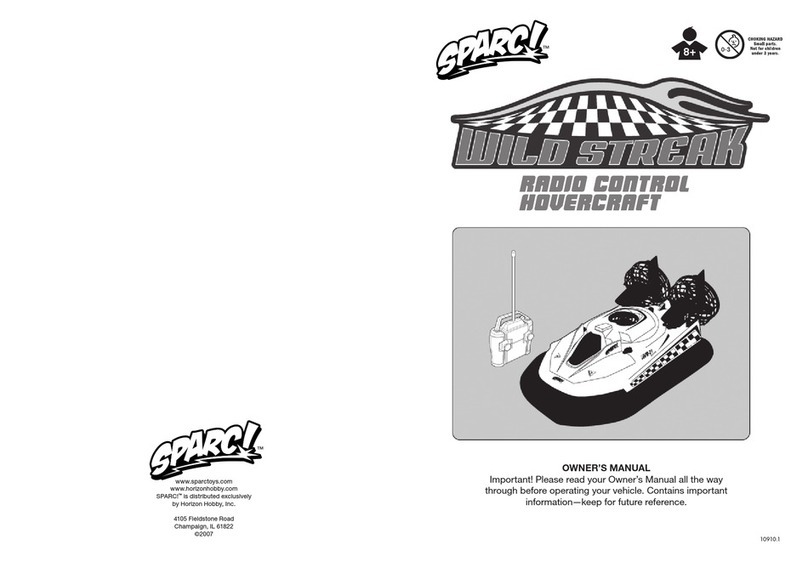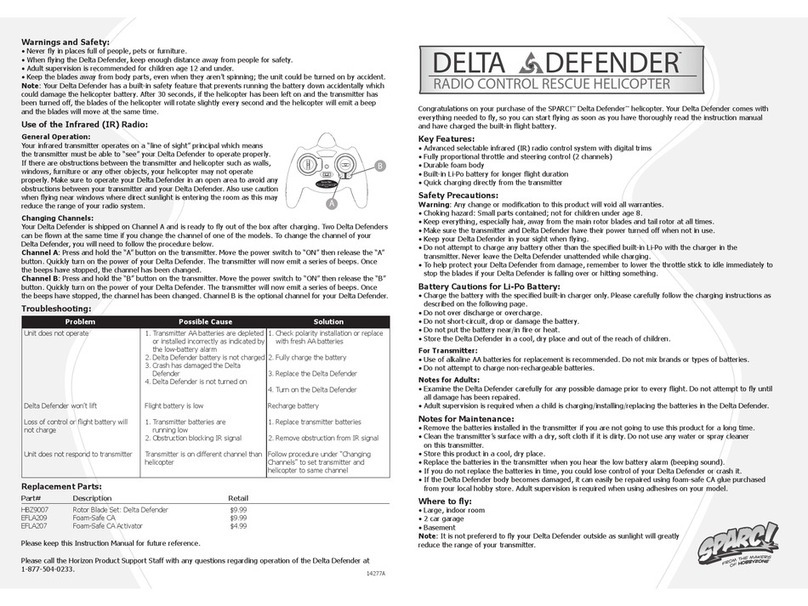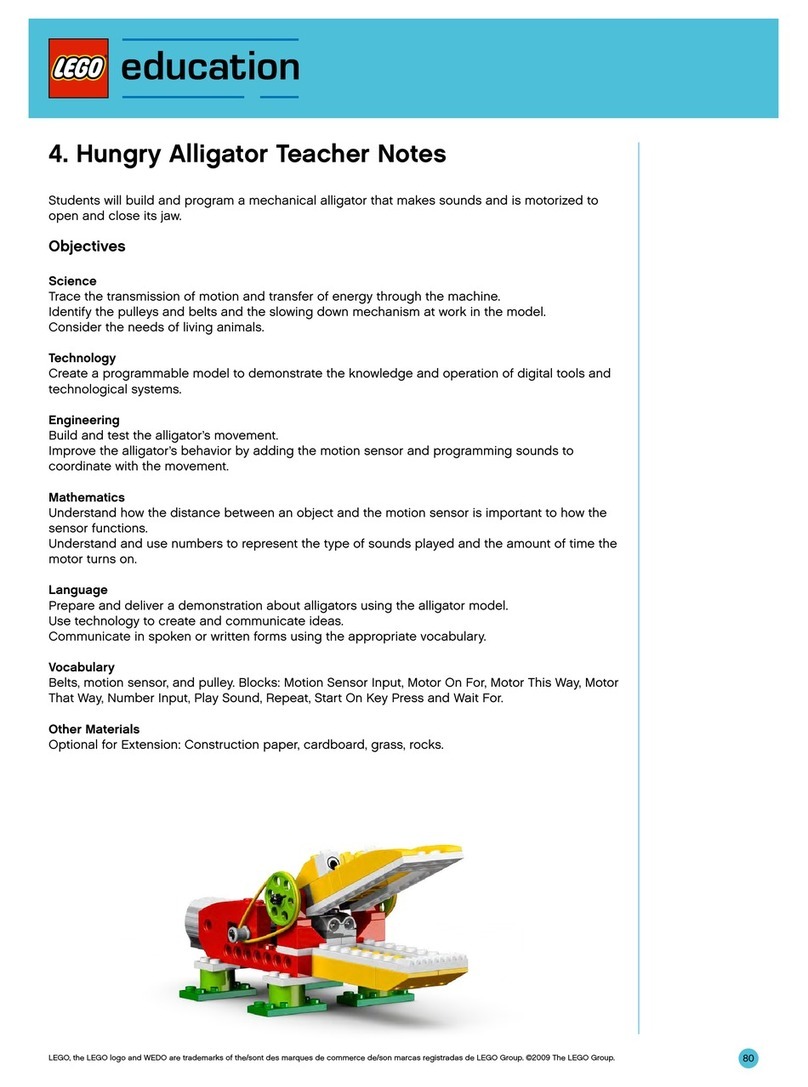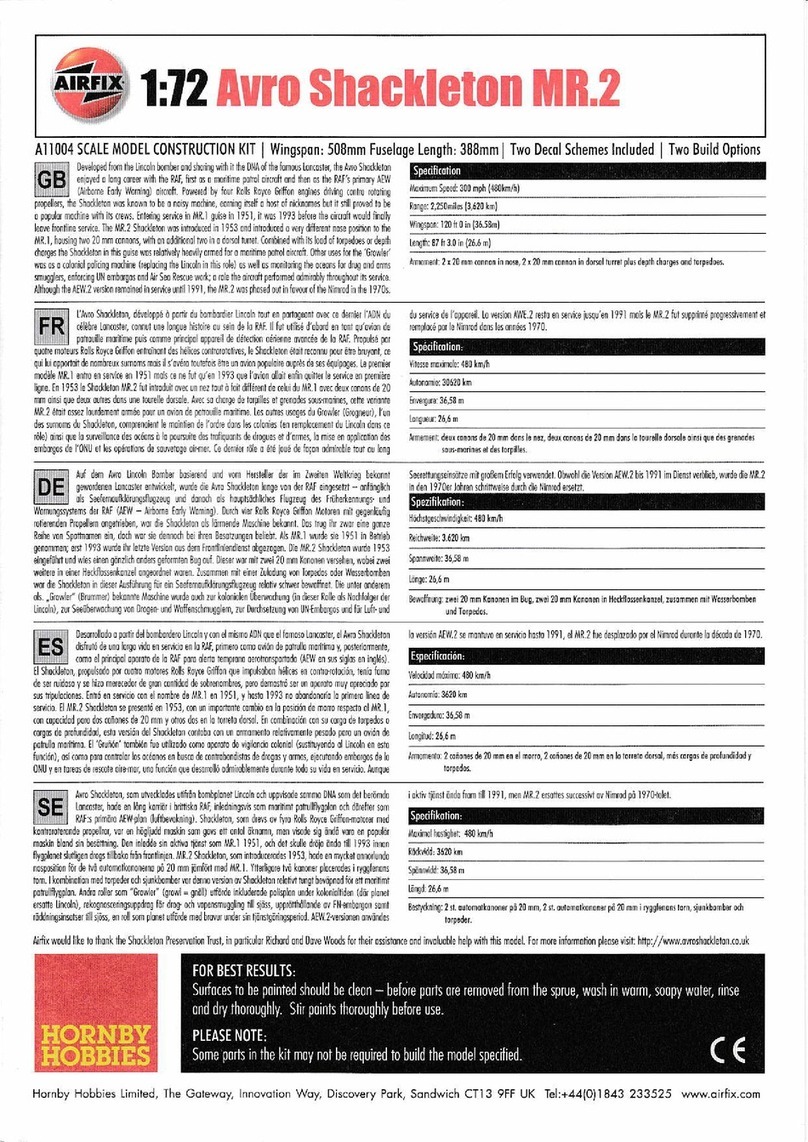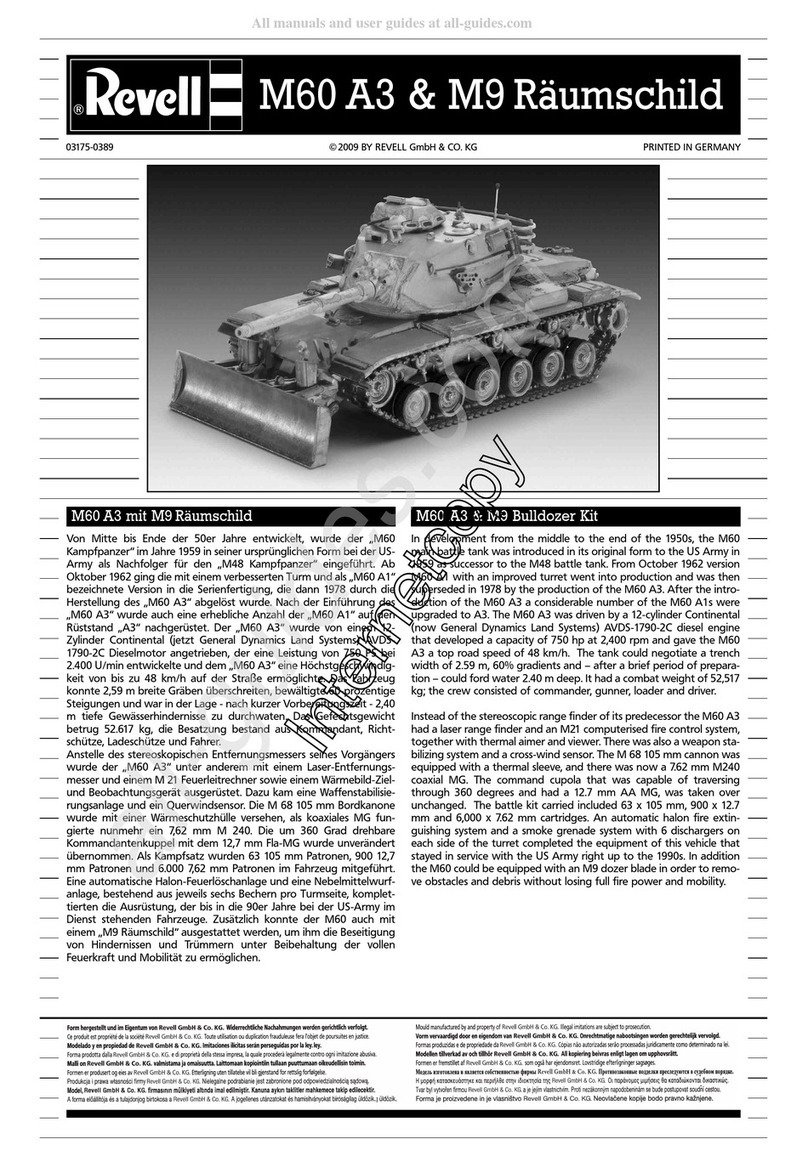Sparc Arrowhead SPJ1300 User manual

OWNER’S MANUAL
Keep these instructions for future reference as they
contain important information.
Sparc!™is distributed exclusively
by Horizon Hobby Inc.
Champaign, IL 61822
©2007
www.sparctoys.com
www.horizonhobby.com
RADIO CONTROL ATTACK CHOPPER
.5$%
10912.1
™
™
CHOKING HAZARD
Small parts.
Not for children
under 3 years.

2
3
AB DC
1
2
3
5
6
7
8
9
4
1
2
1
1
212
6
5
3
7
4
Safety First
CAUTION: TO AVOID BATTERY
LEAKAGE OF AA BATTERIES FOR
TRANSMITTER
• Use AA batteries for transmitter.
• Make sure the batteries are inserted with
correct polarity and follow the battery
manufacturer’s instructions.
• After use, remove the batteries from
the transmitter to store.
• Do not attempt to short-circuit,
charge, disassemble or heat batteries.
Do not dispose of batteries in re or
get them wet.
• If battery uid contacts your eyes, skin
or clothes, immediately wash them
with water and consult a doctor.
• Do not mix new and old batteries
together in the transmitter.
Precautions Before Flight
Depending on ight conditions or due to
improper control, ying a helicopter can
be hazardous, resulting in unforeseen
accidents such as bodily injury and
property damage. The helicopter
operator shall be held responsible for
such an accident.
WARNINGS DURING PLAYING
• After use, store the helicopter in a
place out of the reach of children 3
years old or younger.
• To avoid hazards from improper use,
this helicopter is not intended for
children under 14 years old. Adult
supervision is required.
• Make sure you have plenty of open
space in all directions. Fly the
helicopter in a safe area away from
people, pets, etc.
• Do not y the helicopter toward a per-
son; otherwise, an injury may occur.
• Do not store the helicopter near a
heater or any place where the
temperature rises (e.g., a closed up
car in summer).
• Do not y the helicopter on windy days
or in bad weather conditions.
• Fly the helicopter away from roads,
railways and power lines. Avoid
crowded and narrow areas.
• If the helicopter gets stuck in a tree,
building or power line, do not climb to
retrieve it. Contact the owner or the
power company in such a case.
• Do not bring your face or hands near
the rotor. For safety, you are recom-
mended to wear goggles.
• Do not use the helicopter if it is irrepara-
bly damaged.
• When the helicopter is in ight, adult
supervision is required.
• Do not touch charging terminals
(i.e., the metal part) on the helicopter
body or the charger.
• The helicopter is intended for outdoor
use only.
• Do not point the transmitter antenna
toward a person or animal’s head,
otherwise, an unforeseen accident
may occur. Also, do not bend
the antenna.
• Never attempt to disassemble or
modify the helicopter.
• Do not bend or pull the components
with a strong force.
• Do not operate the helicopter with the
main rotor locked.
• Do not drop or smash the batteries,
transmitter or charger. Otherwise, the
charging port, charger, batteries or
transmitter may be damaged.
• When charging is complete, remove
the charger connector from the charg-
ing port on the helicopter, then unplug
the charger from the wall outlet.
• Check if a nearby transmitter is produc-
ing interference or signals with the same
frequency. In such a case, move to
another place or wait until the other user
has nished operating his/her vehicle.
Precautions
Handling of Li-Po Batteries
and Charger
This product contains a high-perfor-
mance Lithium Polymer battery. The
battery features large capacity and high
voltage and has a lightweight design,
which is best suited for use in RC heli-
copters. Because of the extremely large
energy content, be sure to handle the
battery with care.
CAUTION: TO AVOID BATTERY
LEAKAGE OF BUILT-IN LI-PO
RECHARGEABLE BATTERIES
• Charge batteries following the battery
and charger manufacturer’s instructions.
• Charge batteries with the included
charger BEFORE the rst use.
• Do not charge batteries with a charger
other than the one included.
• Do not charge batteries, other than the
built-in Li-Po battery, with the included
charger or use the charger as the
power source for other equipment.
• Do not charge batteries within the
reach of small children.
• Do not drop or smash the batteries or
the charger during charging.
• Do not recharge a Li-Po battery that
is already fully charged or the battery
may be damaged. Li-Po batteries have
a low natural discharge rate and do not
require recharging in the rst one or
two hours after a charge.
• When charge is complete, unplug the
charger from the wall outlet.
• After use, be sure to turn the switch
off. Failure to do so may adversely
affect the batteries, resulting in a
disabled charge.
• Do not short-circuit battery terminals,
or the battery may swell and get hot,
leading to re.
• Do not heat, disassemble or modify
batteries. Do not dispose of batteries
in re or allow them to get wet.
• Do not use, store or charge batter-
ies in a place near a heater, or in high
temperature or humid conditions.
Battery Disposal
Instructions
The built-in Li-Po battery, when used
under normal conditions, is capable of
approximately 200 charge/discharge
cycles.
THIS PRODUCT USES A
LITHIUM POLYMER BATTERY
AND MUST BE RECYCLED OR
DISPOSED OF PROPERLY.
Contact your local area ofce of solid
waste management or other appropriate
local agency for information. Do not
attempt to disassemble the battery
before disposal.
Precautions I. CONTENTS & FEATURES
This kit includes:
A. Arrowhead x 1
B. Transmitter x 1
C. Transmitter antenna x 1
D. Charger x 1
1Arrowhead
1Stabilizer
2Main rotor
3Tail rotor
4LED lamp (on bottom)
5Wings (see instructions below)
6Antenna
* Do not cut the antenna wire.
77.4V Li-Po battery embedded
8Skid
9Charging port / Power switch
(at the bottom)
RADIO CONTROL ATTACK CHOPPER
.5$%
Wing Installation:
Your Arrowhead Attack Chopper includes
optional wings that may be attached for
added realism. To attach wings, simply
install the wing panel containing the tab
into the side of the helicopter body. The
second wing panel will slide into the
opposite side of the body and will be
secured by the tab.
2Transmitter
Front
1Antenna
2Elevator stick
3Throttle stick (up/down),
Rudder stick (left/right)
4Rudder trim
5Power indicator
6Power switch
Rear
7Battery door
FCC STATEMENT
This device complies with part 15 of the FCC Rules.
Operation is subject to the following two conditions:
• This device may not cause harmful interference
• This device must accept any interference
received, including interference that may cause
undesired operation.
Changes or modications to this unit not expressly
approved by the party responsible for compliance
could void the user’s authority to operate
the equipment.

4
5
12
-1
-1
-1
-1
-1
1
1 1
3 3
2
2
23
11
4 4
1
2
2
-1
4
II. INSTALLATION
1Transmitter Antenna Installation/Removal
1Antenna Installation
Turn the antenna clockwise to screw it into the transmitter
body. Securely screw it in place, or a malfunction may result
from having a loose antenna connection.
2Antenna Removal
Turn the antenna counterclockwise to remove it. When
housing the antenna, retract it from the root rib to avoid
bending the antenna rod.
2Transmitter Battery Installation
Use eight AA batteries for the transmitter.
1Slide open the BATTERY DOOR in the direction shown.
2Insert AA BATTERIES with the polarity (+/-) as shown.
3Replace BATTERY DOOR.
* When the capacity of the batteries becomes low, the Power
LED lamp changes from steady to blinking. You need to
replace the batteries, or a malfunction may occur due to
reduced operating range.
AB DC
1
2
3
5
6
7
8
9
4
1
2
1
1
212
6
5
3
7
4
12
-1
-1
-1
-1
-1
1
1 1
3 3
2
2
23
11
4 4
1
2
2
-1
4
III. BUILT-IN BATTERY CHARGING INSTRUCTIONS
Adult Supervision Required
A rechargeable battery is built into the helicopter body. Be
sure to charge the battery before you use it. The built-in Li-Po
battery, if not handled properly, may explode, cause burns or
catch re, resulting in a serious accident.
1Set the power switch of the helicopter to “OFF”, connect
the charger connector to the charging port on the helicop-
ter, then plug the charger into a standard wall outlet.
1-1 Charging port.
2LED lamp on charger will light to show the charger is
operating.
2-1 LED lamp
3When charging is complete, the LED lamp goes off. Re-
move the charger connector from the charging port on the
helicopter, then unplug the charger from the wall outlet.
* Battery charging time varies with battery level. As a guide,
it takes approximately 1 hour when the battery is near
empty, or 30 minutes if it is half-empty.
Important:
To prevent overcharge of batteries, do not repeak a Li-Po
battery that has peaked. The battery, if not used to y the
helicopter, does not require charging in the rst one or two
hours after a charge.
IV. HOW TO FLY
1Preparation for Flight
1Turn on the switch on the transmitter. Then, the LED lamp
will start blinking.
1-1 LED lamp (blinking)
2Completely extend the transmitter antenna.
3Turn on the switch on the helicopter body, then the LED
lamp will start blinking. When the LED lamp changes to
steady, the helicopter is ready for ight.
3-1 LED lamp
4Move the throttle stick to the top position, then to the
bottom. The transmitter is ready to operate when the LED
indicator changes from blinking to steady.
4-1 LED lamp (not blinking)
5Stay at least 10–15 ft (4–5 m) away from the helicopter
before ying it.
6Only operate the helicopter in environments free from
obstructions.
12
-1
-1
-1
-1
-1
1
1 1
3 3
2
2
23
11
4 4
1
2
2
-1
4
12
-1
-1
-1
-1
-1
1
1 1
3 3
2
2
23
11
4 4
1
2
2
-1
4
12
-1
-1
-1
-1
-1
1
1 1
3 3
2
2
23
11
4 4
1
2
2
-1
4
12
-1
-1
-1
-1
-1
1
1 1
3 3
2
2
23
11
4 4
1
2
2
-1
4
Note: Flying an RC helicopter is an exciting and challenging experience, and requires some practice. Be sure to use gentle
controls on the radio so that you can get used to the way the helicopter responds. Take your time, and make sure you y
in an area with plenty of space. In the beginning, it is important that you focus on making small movements on the control
sticks of the transmitter. As you get more comfortable with the way your helicopter ies, you will be able to use the full range
of controls. If you have never own an RC helicopter before, we recommend that you have an experienced RC pilot present
during your rst few ights.

6
7
-1 -2
-1 -2
-1 -2
-3
11
1
23
3
2
1 1
22
IV. HOW TO FLY
2Transmitter Functions
1Throttle stick (left) (Up/Down)
Moving the throttle stick toward the top of the transmitter allows the helicopter to ascend, and moving the stick back
makes the helicopter descend.
1-1 Up
1-2 Down
2Rudder stick (left) (Left / Right)
Moving the rudder stick left allows the helicopter to turn left, and moving the stick right makes the helicopter turn right.
2-1 Left turn
2-2 Right turn
2-3 Rudder trim
* If the helicopter rotates nose left or right by itself, without commanded input from the stick, it needs to be trimmed to stop
the rotation.
* Move the rudder trim left if the nose of the helicopter rotates to the right, and move the rudder trim right if the nose of the
helicopter rotates to the left.
3Elevator stick (right)
Moving the elevator stick toward the top of the transmitter allows the helicopter to y forward.
-1 -2
-1 -2
-1 -2
-3
11
1
23
3
2
1 1
22
-1 -2
-1 -2
-1 -2
-3
11
1
23
3
2
1 1
22
3Fly the Helicopter
1Slowly move the throttle stick (left) up to make the helicopter take off. When the helicopter is slightly oating, slowly
move the stick back to make it land. Gradually increase the height as you get accustomed to the controls, and adjust
the stick up and down to get the feeling of hovering.
* To move the helicopter down, move the throttle stick back more slowly than when moving the helicopter up.
* The throttle stick should be moved in small increments of a few millimeters. For this operation, proper training is required.
As a feature of a contra-rotating rotor helicopter, hovering can be achieved rather easily.
1-1 Up
1-2 Down
2When the helicopter reaches hovering, make it rotate at its position. Move the rudder stick (left) of the transmitter left or
right to change the direction of the helicopter. If the helicopter rotates by itself, adjust the rudder trim to stop the rotating.
2-1 Left turn
2-2 Right turn
2-3 Rudder trim
-1 -2
2 2
3
4
2-3
2
-1 -2
-1 -2
-1 -2
-3
11
1
23
3
2
1 1
22
-1 -2
-1 -2
-1 -2
-3
11
1
23
3
2
1 1
22
3When you get accustomed to the control of hovering and rotating, move the forward stick (right) on the transmitter up to
y the helicopter forward. The helicopter will keep ying forward while the stick is moved up and held in position. To stop
it, move the stick back. The helicopter cannot smoothly y forward while it is rotating. Stop the rotating before ying the
helicopter forward.
If you are comfortable with steps 1 to 3, try to conduct two operations at the same time. After that, you can freely y the
helicopter by conducting any combination of operations.
-1 -2
2 2
3
4
2-3
2
-1 -2
2 2
3
4
2-3
2
Important:
If the helicopter crashes, immediately move the throttle stick (left)
back, otherwise damage may result from idling the main motor.
4After use, turn off the switch on the helicopter, then turn off the
transmitter. Be sure to retract the transmitter antenna.
Important:
This helicopter is equipped with a feature for monitoring the
charge level of the built-in battery. The LED lamp blinks if the
charge level becomes low. Turn off the switch when the LED
lamp starts blinking. Failure to do so may adversely affect
batteries, resulting in permanent damage.

8
9
V. FLIGHT LOCATION
AND CONDITION
Flight Location
Check that there are no obstacles around the ight location before ying the helicopter.
• Fly the helicopter in a safe area away from roads, other persons and animals, trees, buildings, overhead power lines and
other obstacles.
TROUBLESHOOTING GUIDE
Check the following items if your Arrowhead is not operating properly:
• Make sure the power is on.
• Make sure the main battery and the transmitter battery have sufcient charge.
• Check if the main battery and the transmitter battery are inserted with correct polarity.
• Check if the antenna of the transmitter is broken.
• Check if the distance between the transmitter and the helicopter exceeds 20 meters.
• Check if a nearby transmitter produces interference or signals on the same frequency.
Unlike other radio control helicopters, the AH-78 Arrowhead has a number of replacement parts available in the event of
damage. These parts are easily replaced with common household tools, and should be available at any hobby store that
carries SPARC!™ products.
Replacement Parts
SPJ1001 Skid Set $3.99
SPJ1004 Transmitter Antenna $5.99
SPJ1005 Transmitter Battery Cover $3.99
SPJ1302 Rotor Blade Set: Arrowhead $7.99
SPJ1303 Body Set: Arrowhead $11.99
SPJ1306 Battery Charger: Arrowhead $15.99
-1 -2
2 2
3
4
2-3
2
Flight Condition
For best performance, y the helicopter when the air temperature is above 50 degrees Fahrenheit. The Arrowhead is powered
by a lithium polymer battery that suffers signicantly decreased performance at low temperatures. Avoid locations exposed
to wind, otherwise the helicopter may become uncontrollable. Do not y the helicopter in bad weather (heavy thunderstorms,
rain, sleet, snow, etc.).
Important:
• Ensure that a nearby transmitter does not produce interference or signals with the same frequency.
• Always supervise the helicopter in ight.
• Adult supervision is required when children 14 and under are ying the helicopter.
• The helicopter is intended for outdoor use.
VI. MAINTENANCE
Care and Service
• The life of the helicopter can be extended with daily care. Keep the Arrowhead clean, and check for damage and loose
parts after every ying session or after a crash.
• The helicopter body is made of polystyrene foam. If damaged, use clear tape or a suitable adhesive to repair. Foam-safe
CA can be purchased from your local hobby shop.
• Never use instant glue, which will make the polystyrene foam dissolve.
• The helicopter may lose balance and not y correctly if broken. If, after a repair, the helicopter wants to y backward, try
taping a small amount of weight under the nose of the helicopter, or use a small wad of modeling clay. Likewise, if it wants
to y forward and won’t stop going forward, tape a very small weight to the tail.

10
11
Warranty Period
Exclusive Warranty- Horizon Hobby, Inc., (Horizon)
warranties that the Products purchased (the “Product”)
will be free from defects in materials and workmanship at
the date of purchase by the Purchaser.
Limited Warranty
(a) This warranty is limited to the original Purchaser
(“Purchaser”) and is not transferable. REPAIR OR RE-
PLACEMENT AS PROVIDED UNDER THIS WARRANTY
IS THE EXCLUSIVE REMEDY OF THE PURCHASER.
This warranty covers only those Products purchased
from an authorized Horizon dealer. Third party transac-
tions are not covered by this warranty. Proof of purchase
is required for warranty claims. Further, Horizon reserves
the right to change or modify this warranty without notice
and disclaims all other warranties, express or implied.
(b) Limitations HORIZON MAKES NO WARRANTY OR
REPRESENTATION, EXPRESS OR IMPLIED, ABOUT
NON-INFRINGEMENT, MERCHANTABILITY OR FITNESS
FOR A PARTICULAR PURPOSE OF THE PRODUCT. THE
PURCHASER ACKNOWLEDGES THAT THEY ALONE
HAVE DETERMINED THAT THE PRODUCT WILL
SUITABLY MEET THE REQUIREMENTS OF THE
PURCHASER’S INTENDED USE.
(c) Purchaser Remedy Horizon’s sole obligation
hereunder shall be that Horizon will, at its option,
(i) repair or (ii) replace, any Product determined by
Horizon to be defective. In the event of a defect, these
are the Purchaser’s exclusive remedies. Horizon
reserves the right to inspect any and all equipment
involved in a warranty claim. Repair or replacement
decisions are at the sole discretion of Horizon. This
warranty does not cover cosmetic damage or damage
due to acts of God, accident, misuse, abuse, negligence,
commercial use, or modication of or to any part of the
Product. This warranty does not cover damage due to
improper installation, operation, maintenance, or at-
tempted repair by anyone other than Horizon. Return
of any goods by Purchaser must be approved in writing
by Horizon before shipment.
Damage Limits
HORIZON SHALL NOT BE LIABLE FOR SPECIAL,
INDIRECT OR CONSEQUENTIAL DAMAGES, LOSS OF
PROFITS OR PRODUCTION OR COMMERCIAL LOSS IN
ANY WAY CONNECTED WITH THE PRODUCT, WHETHER
SUCH CLAIM IS BASED IN CONTRACT, WARRANTY,
NEGLIGENCE, OR STRICT LIABILITY. Further, in no event
shall the liability of Horizon exceed the individual price of
the Product on which liability is asserted. As Horizon has
no control over use, setup, nal assembly, modication or
misuse, no liability shall be assumed nor accepted for any
resulting damage or injury. By the act of use, setup or as-
sembly, the user accepts all resulting liability.
If you as the Purchaser or user are not prepared to accept
the liability associated with the use of this Product, you
are advised to return this Product immediately in new and
unused condition to the place of purchase.
Law
These Terms are governed by Illinois law
(without regard to conflict of law principals).
Safety Precautions
This is a sophisticated R/C product and must be operated
with caution and common sense and requires some basic
mechanical ability. Failure to operate this Product in a safe
and responsible manner could result in injury or damage to
the Product or other property. This Product is not intended
for use by children without direct adult supervision. The
Product manual contains instructions for safety, operation
and maintenance. It is essential to read and follow all the
instructions and warnings in the manual, prior to assembly,
setup or use, in order to operate correctly and avoid
damage or injury.
Questions, Assistance, and Repairs
Your local hobby store and/or place of purchase cannot
provide warranty support or repair. Once assembly, setup
or use of the Product has been started, you must contact
Horizon directly. This will enable Horizon to better answer
your questions and service you in the event that you may
need any assistance. For questions or assistance, please
direct your email to productsupport@horizonhobby.com, or
call 877.504.0233 toll free to speak to a service technician.
Warranty Inspection and Repairs
To receive warranty service, you must include your original
sales receipt verifying the proof-of-purchase date. Provided
warranty conditions have been met, your Product will be
repaired or replaced free of charge. Repair or replacement
decisions are at the sole discretion of Horizon Hobby.
Pack the Product securely using a shipping carton.
Please note that original boxes may be included, but are
not designed to withstand the rigors of shipping without
additional protection. Ship via a carrier that provides track-
ing and insurance for lost or damaged parcels, as Horizon
is not responsible for merchandise until it arrives and is
accepted at our facility. A Service Repair Request is avail-
able at www.horizonhobby.com on the “Support” tab. If you
do not have internet access, please include a letter with your
complete name, street address, email address and phone
number where you can be reached during business days,
your RMA number, a list of the included items, method of
payment for any non-warranty expenses and a brief sum-
mary of the problem. Your original sales receipt must also
be included for warranty consideration. Be sure your name,
address, and RMA number are clearly written on the outside
of the shipping carton.
All other Products requiring warranty inspection or repair
should be shipped to the following address:
Horizon Product Support
4105 Fieldstone Road
Champaign, Illinois 61822
Please call 877-504-0233 with any questions or
concerns regarding this product or warranty.
WARRANTY
Table of contents
Other Sparc Toy manuals
Popular Toy manuals by other brands

PIKO
PIKO TRAXX F140 M Instructions for use

LEGO
LEGO 10567 instructions
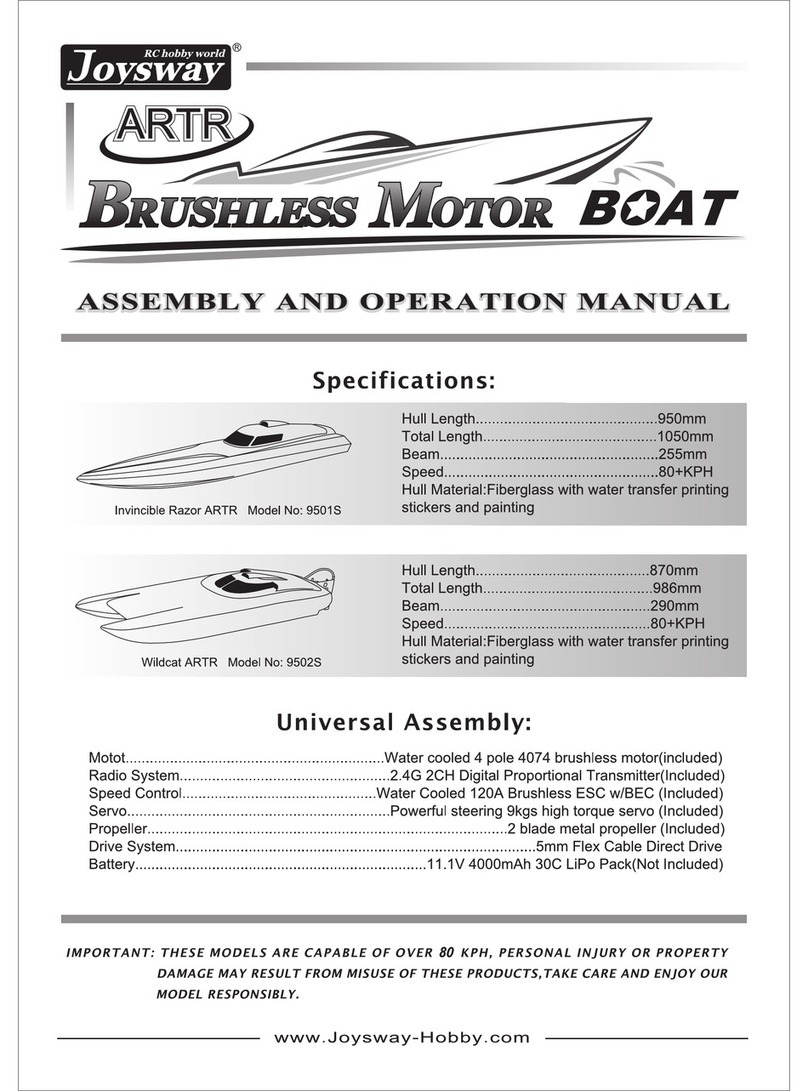
Joysway
Joysway Invincible Razor ARTR 9501S Assembly and operation manual
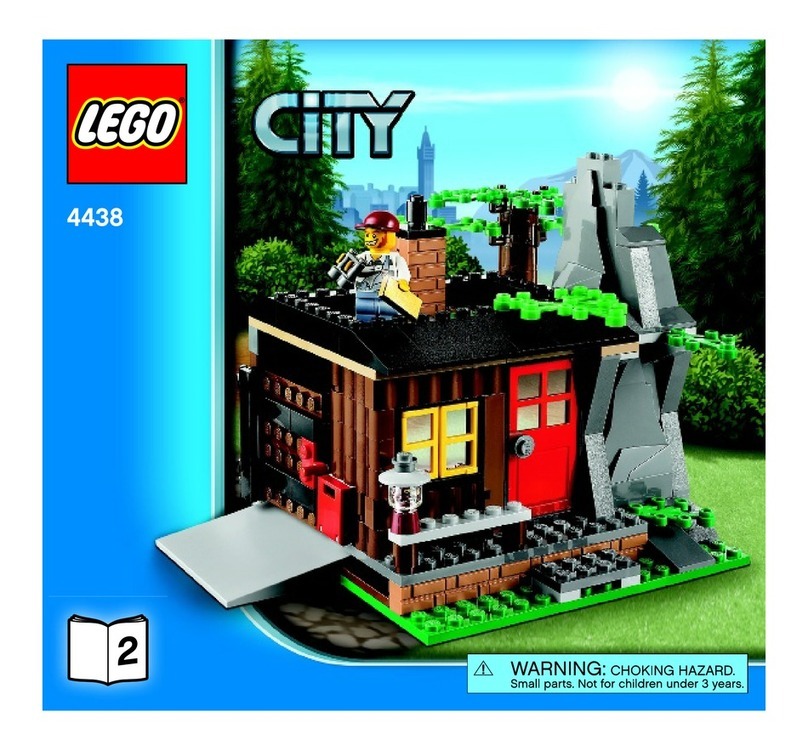
LEGO
LEGO 4438 CiTY Assembly guide
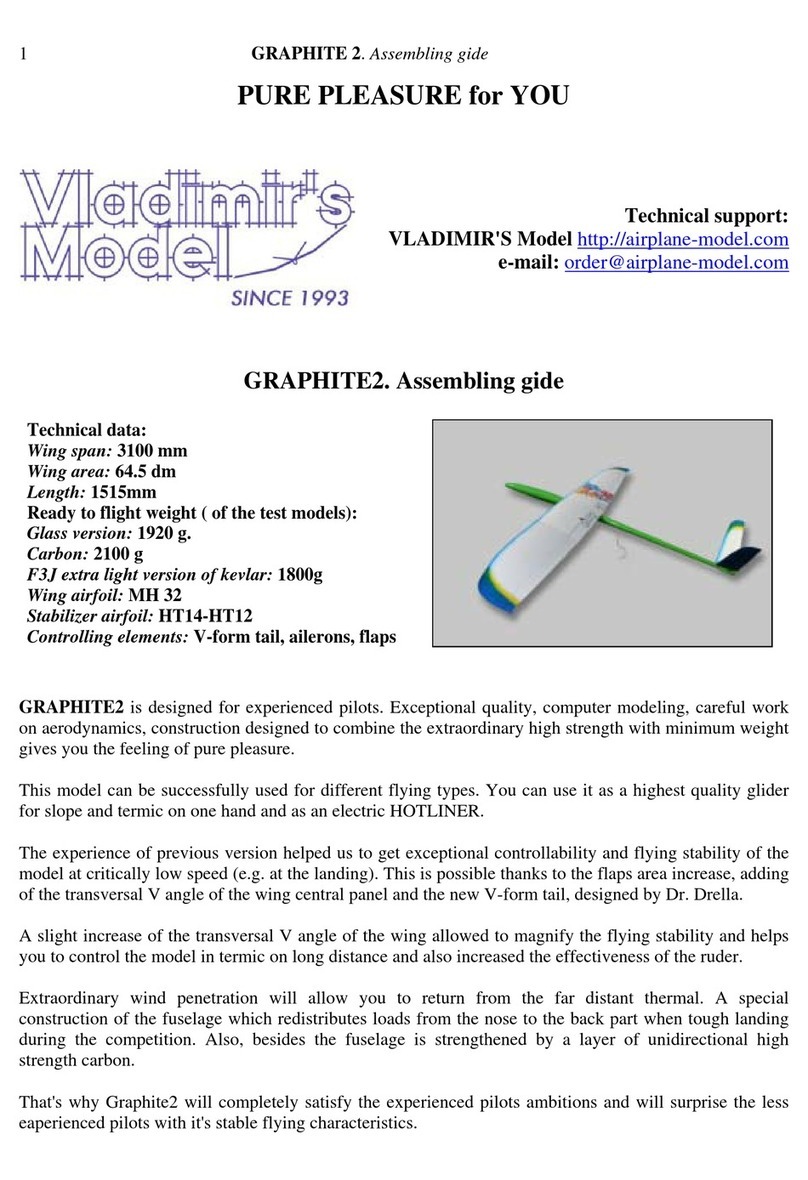
Vladimir's Models
Vladimir's Models GRAPHITE 2 Assembling Guide

MTHTrains
MTHTrains PREMIER AC6000 DIESEL ENGINE operating instructions
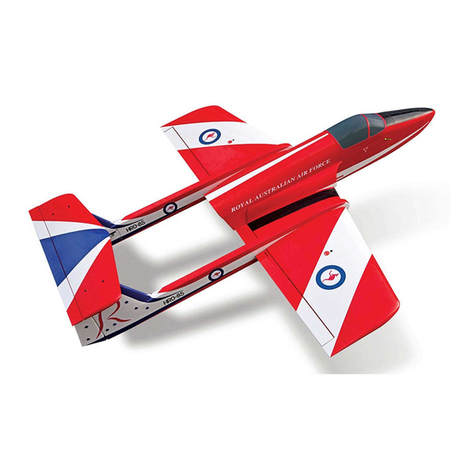
Ripmax
Ripmax NANO Boomerang instruction manual
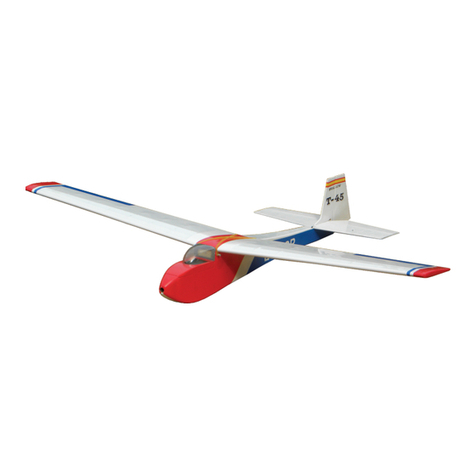
VQ Radio Control Model
VQ Radio Control Model Swallow instruction manual

Fisher-Price
Fisher-Price P9512 instructions

Mega Bloks
Mega Bloks STAR TREK DPH80 manual

Mega Bloks
Mega Bloks Barbie Build'n Play Luxury Yacht manual
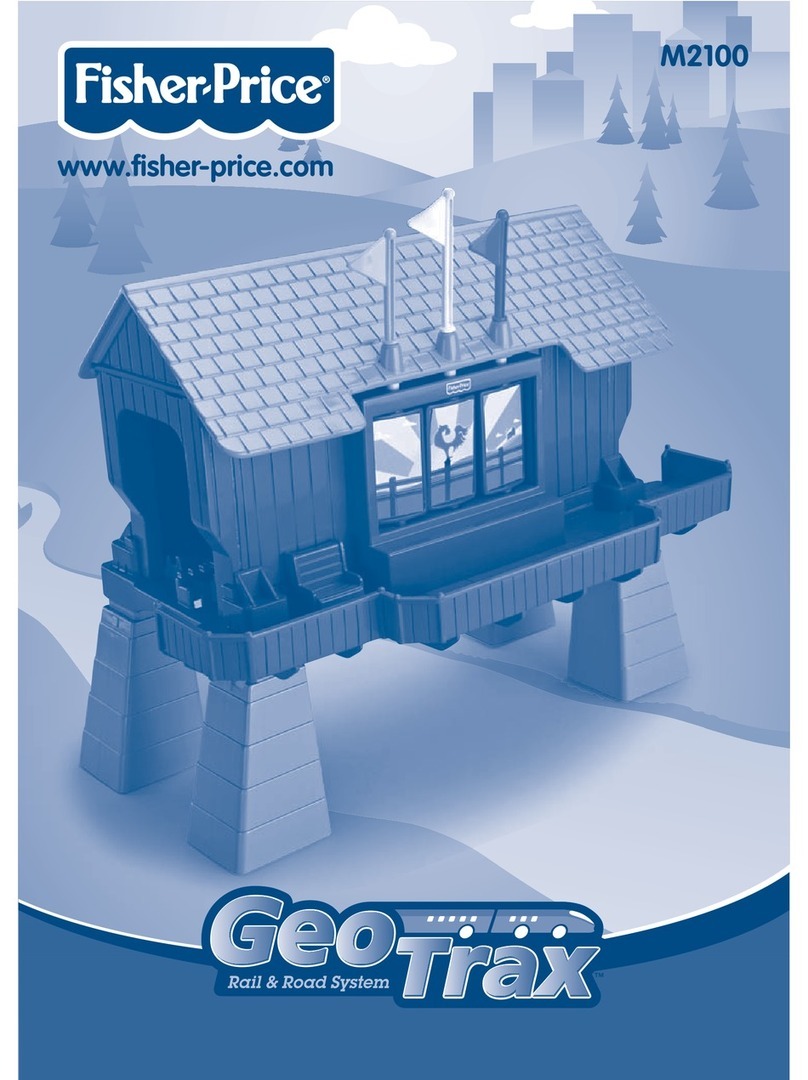
Fisher-Price
Fisher-Price GEO TRAX M2100 user manual
